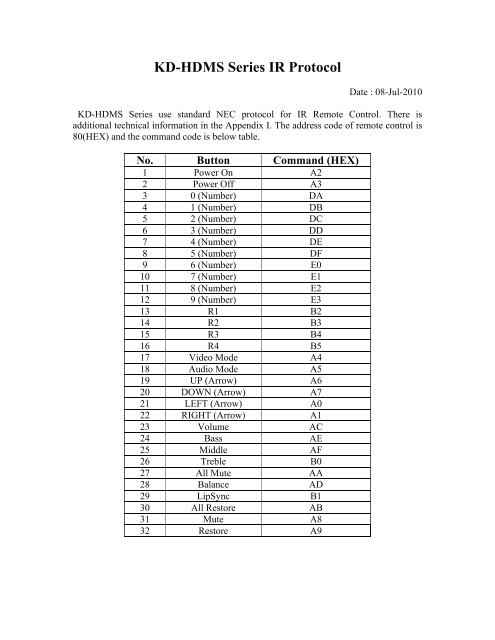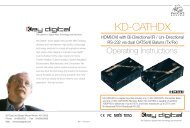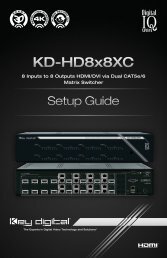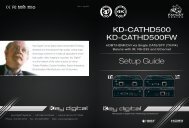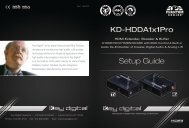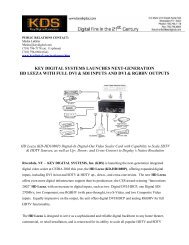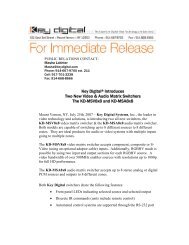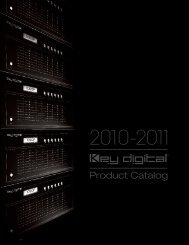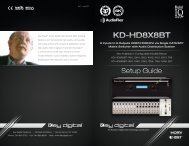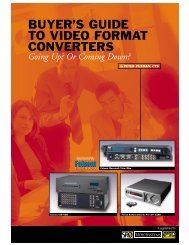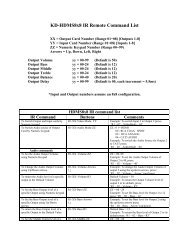KD-HDMS Series IR Protocol - Key Digital
KD-HDMS Series IR Protocol - Key Digital
KD-HDMS Series IR Protocol - Key Digital
You also want an ePaper? Increase the reach of your titles
YUMPU automatically turns print PDFs into web optimized ePapers that Google loves.
<strong>KD</strong>-<strong>HDMS</strong> <strong>Series</strong> <strong>IR</strong> <strong>Protocol</strong><br />
Date : 08-Jul-2010<br />
<strong>KD</strong>-<strong>HDMS</strong> <strong>Series</strong> use standard NEC protocol for <strong>IR</strong> Remote Control. There is<br />
additional technical information in the Appendix I. The address code of remote control is<br />
80(HEX) and the command code is below table.<br />
No. Button Command (HEX)<br />
1 Power On A2<br />
2 Power Off A3<br />
3 0 (Number) DA<br />
4 1 (Number) DB<br />
5 2 (Number) DC<br />
6 3 (Number) DD<br />
7 4 (Number) DE<br />
8 5 (Number) DF<br />
9 6 (Number) E0<br />
10 7 (Number) E1<br />
11 8 (Number) E2<br />
12 9 (Number) E3<br />
13 R1 B2<br />
14 R2 B3<br />
15 R3 B4<br />
16 R4 B5<br />
17 Video Mode A4<br />
18 Audio Mode A5<br />
19 UP (Arrow) A6<br />
20 DOWN (Arrow) A7<br />
21 LEFT (Arrow) A0<br />
22 RIGHT (Arrow) A1<br />
23 Volume AC<br />
24 Bass AE<br />
25 Middle AF<br />
26 Treble B0<br />
27 All Mute AA<br />
28 Balance AD<br />
29 LipSync B1<br />
30 All Restore AB<br />
31 Mute A8<br />
32 Restore A9
Appendix I<br />
Technical Document for NEC protocol<br />
1. Features<br />
- 8 bit address and 8 bit command length<br />
- Address and command are transmitted twice for reliability<br />
- Pulse distance modulation<br />
- Carrier frequency of 38kHz<br />
- Bit time of 1.125ms or 2.25ms<br />
2. Modulation<br />
The NEC protocol uses pulse distance encoding of the bits. Each pulse is a 560s long<br />
38kHz carrier burst (about 21 cycles). A logical "1" takes 2.25ms to transmit, while a<br />
logical "0" is only half of that, being 1.125ms. The recommended carrier duty-cycle is<br />
1/4 or 1/3.<br />
3. <strong>Protocol</strong><br />
The picture above shows a typical pulse train of the NEC protocol. With this protocol<br />
the LSB is transmitted first. In this case Address 59(HEX) and Command 16(HEX) is<br />
transmitted. A message is started by a 9ms AGC burst, which was used to set the gain<br />
of the earlier <strong>IR</strong> receivers. This AGC burst is then followed by a 4.5ms space, which is<br />
then followed by the Address and Command. Address and Command are transmitted<br />
twice. The second time all bits are inverted and can be used for verification of the<br />
received message. The total transmission time is constant because every bit is repeated<br />
with its inverted length. If you're not interested in this reliability you can ignore the<br />
inverted values, or you can expand the Address and Command to 16 bits each!
A command is transmitted only once, even when the key on the remote control<br />
remains pressed. Every 110ms a repeat code is transmitted for as long as the key<br />
remains down. This repeat code is simply a 9ms AGC pulse followed by a 2.25ms<br />
space and a 560s burst.


